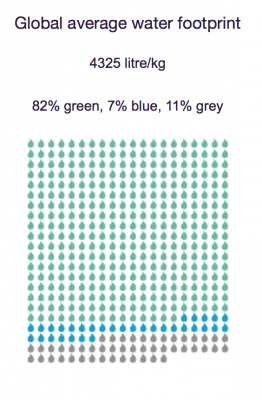We have discussed the CO2 emissions of beef and naturally, the amount of water it takes to produce this beef by raising cattle is extraordinarily high. However, it is just just cows that contribute to our global water footprint, every product does, but especially animal products which require so much water to raise an animal. The Water Footprint Network provides an interactive model that shows how much water it takes to produce many of the foods and products we use daily, including chicken.
According to the article, the average water footprint of chicken is 4330 L/kg, or about 519 gal/lb. Although this quantity is less than other common animals such as cows (15,400 L/kg) or pigs (6000 L/kg). It is important to use tools like this to visualize how our food choices impact the global water footprint.



I found your article very interesting especially since it involves how much water it takes to produce the foods we consume on a daily basis. Surprisingly enough it appears that chickens do consume a considerably large amount of water. Although water consumption does appear rising it would be interesting to look at the food they are also consuming and maybe if the two correlate.
This article reminds me of others I read last week concerning how what we eat really does impact the environment. I remember thinking about how this connects to the trends of becoming vegetarian and vegan. Many people switch to these food trends for a healthier diet, but I wonder if many people also realize that it makes quite a difference in terms of the environment as well.
Our posts seemed to touch on a similar subject, beef and the cattle industry. During my research and calculations, I found that the water footprint of just a single pound of beef is the equivalent of taking a 12 hour shower. This was astonishing to me, though it makes sense. The point you raised about how all animals contribute to our water footprint made me think that, as we too are animals, perhaps we could calculate the water footprint of a single human throughout one’s life just as we would for a single pound of beef or chicken.
Wow, Janet! This post taught me a lot about our environmental relationship with meat. I had no idea that so much water was used to produce beef and chicken. As someone who consumes a lot of both of these foods, this was definitely a shocking thing to learn. I have always thought that vegetarians are fighting against the animal cruelty, but your post taught me that this diet is an environmentally-friendly one as well!